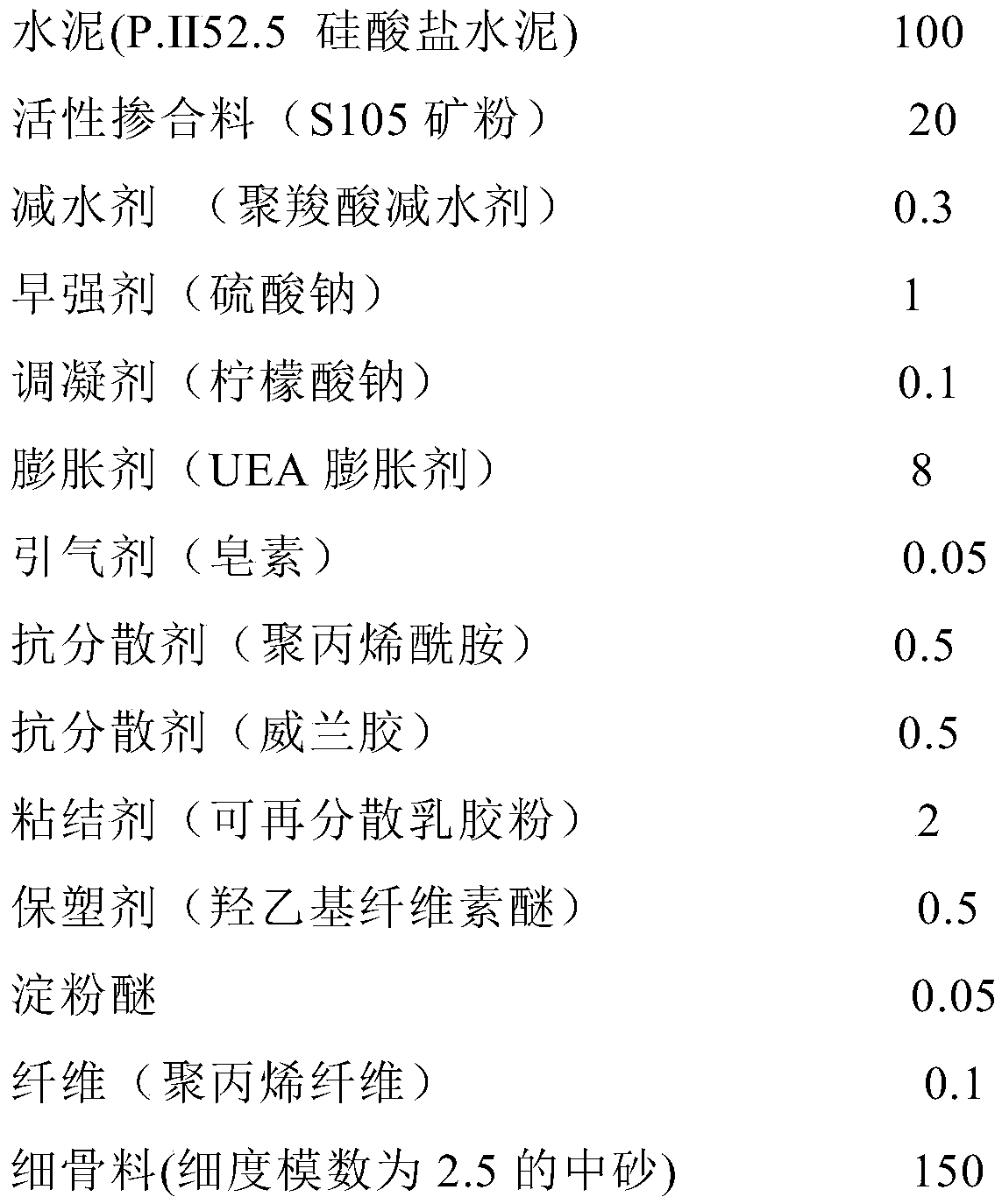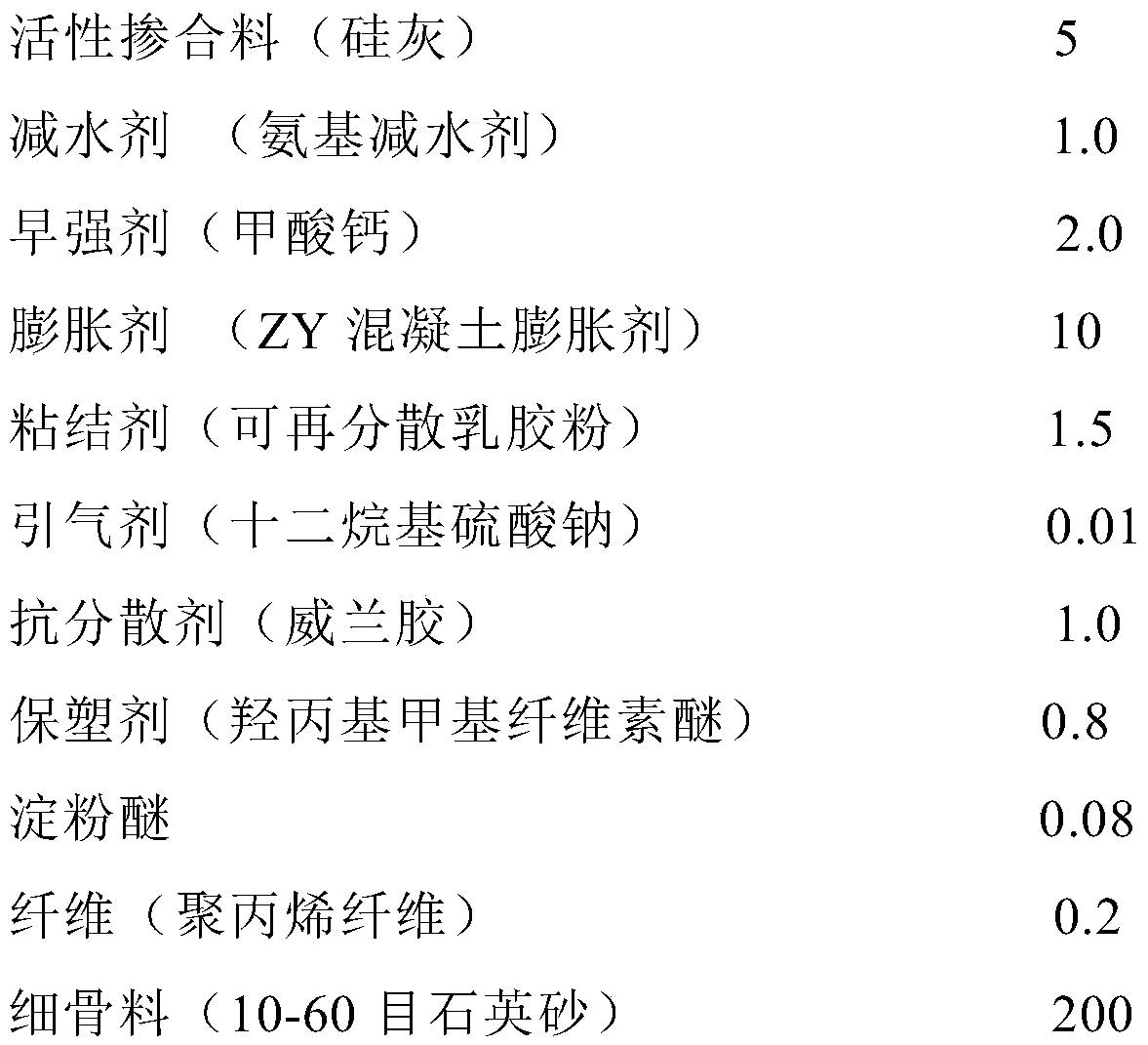A 3D printing cement-based material for underwater construction and its preparation method
A cement-based material, 3D printing technology, applied in the direction of additive processing, sustainable waste treatment, solid waste management, etc., can solve the problems of collapse, poor anti-dispersion performance, etc., achieve small plastic deformation, good crack resistance, water and land The effect of high intensity ratio
- Summary
- Abstract
- Description
- Claims
- Application Information
AI Technical Summary
Problems solved by technology
Method used
Image
Examples
Embodiment 1
[0035]
[0036] Preparation method: Weigh various raw materials according to the formula, and add cement (P.II52.5 Portland cement), active admixture (ultrafine slag powder), water reducer (polycarboxylate water reducer) to the mixer in sequence ), early strength agent (sodium sulfate), coagulation regulator (sodium citrate), expansion agent (UEA expansion agent), air-entraining agent (saponin), anti-dispersion agent (polyacrylamide, welan gum), bonding Agent (redispersible latex powder), plastic retaining agent (hydroxyethyl cellulose ether), starch ether, fiber (polypropylene fiber) are fully stirred evenly to obtain powdery gelatinous material, which is packaged to form a product.
[0037] During on-site construction, weigh the fine aggregate (medium sand with a fineness modulus of 2.5) in proportion, put it into a special mixer and mix it evenly with the powdery cementitious material, add 120kg of water to the 1000kg mixture and mix evenly, and the printed concrete is pr...
Embodiment 2
[0039]
[0040]
[0041] Preparation method: Weigh various raw materials according to the formula, add cement (P.I 52.5 Portland cement), active admixtures (mineral powder, silica fume), water reducer (amino water reducer), early strength Agent (calcium formate), expansion agent (ZY concrete expansion agent), air-entraining agent (sodium lauryl sulfate), anti-dispersion agent (Welan gum), binder (redispersible latex powder), plastic retaining agent (Hydroxypropyl methylcellulose ether), starch ether, fiber (polypropylene fiber) are fully stirred evenly, and packaged to form a product.
[0042] During on-site construction, weigh the fine aggregate (quartz sand of 10-60 mesh) in proportion, put it into a special mixer and mix it evenly with the powdery cementitious material, add 130kg water to the 1000kg mixture and mix evenly, and make the printed concrete mixture , and the printing construction can be carried out. The material properties are shown in Table 1.
Embodiment 3
[0044]
[0045]
[0046] Preparation method: Weigh various raw materials according to the formula, and add cement (P.II52.5R Portland cement), active admixture (ultrafine slag powder, silicon powder), water reducer (polycarboxylic acid water reducer), early strength agent (sodium aluminate), expansion agent (UEA expansion agent), air-entraining agent (saponin), binder (redispersible latex powder), anti-dispersion agent (polyacrylamide), The plasticizer (hydroxyethyl cellulose), starch ether, and fiber (polypropylene fiber) are fully stirred evenly to obtain a powdery gelatinous material, which is packaged to form a product.
[0047] During on-site construction, weigh the fine aggregate (medium sand with a fineness modulus of 2.5) in proportion, put it into a special mixer and mix it with the powdery cementitious material, and add 110kg of water to the 1000kg mixture and mix it evenly to make printed concrete The mixture is ready for printing construction. The material p...
PUM
| Property | Measurement | Unit |
|---|---|---|
| compressive strength | aaaaa | aaaaa |
Abstract
Description
Claims
Application Information
 Login to View More
Login to View More - R&D
- Intellectual Property
- Life Sciences
- Materials
- Tech Scout
- Unparalleled Data Quality
- Higher Quality Content
- 60% Fewer Hallucinations
Browse by: Latest US Patents, China's latest patents, Technical Efficacy Thesaurus, Application Domain, Technology Topic, Popular Technical Reports.
© 2025 PatSnap. All rights reserved.Legal|Privacy policy|Modern Slavery Act Transparency Statement|Sitemap|About US| Contact US: help@patsnap.com



